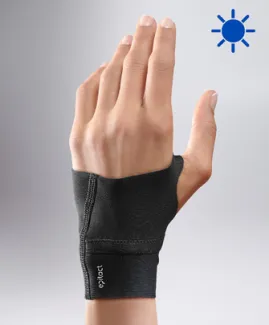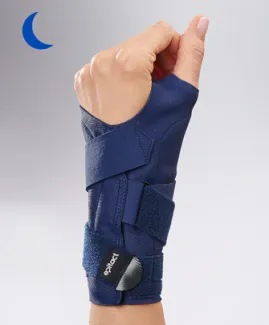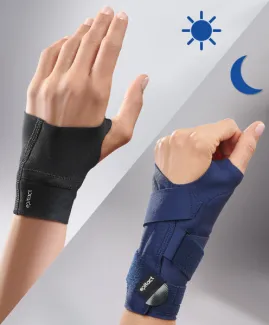
The sensation of pins and needles in the hands and fingers related to carpal tunnel syndrome are due to a nerve problem in the wrist. They often occur at night and during pregnancy.
First, EPITACT® explains what causes pins and needles in the hands, especially the right hand and fingers. Then, we tell you how to stop pins and needles symptoms in the hands.
What do pins and needles mean?
Pins and needles feel like tingling or prickling sensation in the hand and fingers. It is caused by a nerve compression in the wrist.
Why do I have pins and needles in my hands?
The carpal tunnel is located on the inside part of the wrist. Nerves and ligaments are passing through this 'tunnel'. When the median nerve is constantly under pressure, you may be suffering from an inflammation: the carpal tunnel syndrome.
For anatomical, hormonal and also biomechanical reasons, the space reserved for the median nerve in the carpal tunnel is sometimes very limited. This causes the median nerve to be compressed resulting in reduced innervation to the thumb, the index, the middle finger and the inner side of the ring finger.
The symptoms develop slowly, then pains appear. Numbness and tingling in the fingers waking you up at night, loss of strength and loss of feeling in the hands making your daily tasks complicated…
Why do I get pins and needles in my thumb, index and middle fingers?
To answer this question, let’s just focus on the anatomy of the hand and the path of the median nerve.
The median nerve starts from the neck, runs down the shoulder, the arm, the forearm, passes through the wrist in a tunnel (the carpal tunnel) delimited by the wrist bones in the dorsal side and the carpal ligament in the inferior side. Then, it continues in the hand and separates in several branches that spread in the thumb, the index finger, the middle finger and the internal side of the ring finger.
The median nerve is a motor and sensory nerve that mainly gives sensitivity to the skin and allows flexion of the wrist and fingers.
Pins and needles in the right hand, left hand or both?
Sometimes, you can have pins and needles in one hand, sometimes in both hands. Most people complain about pins and needles in their right hand, more than in their left hand. The explanation is quite simple: the dominant hand is more often the right hand, so we use it more and the nerve is also suffering more. Also, even if pins and needles in the right hand are more frequent, carpal tunnel syndrome often affects both hands.
What causes fingers pins and needles at night? How to relieve them?
Pins and needles in the fingers often occur at night because of your sleeping position. While you sleep, you may twist your wrist or put your hand under the pillow, which causes excessive pressure on the wrist. It is also frequent to make extreme flexions and extensions with your wrist and keep it in this position for a long period. You may be waking up with numb hands or having difficulties falling asleep.
And because those movements are unconscious, EPITACT® has created a wrist support brace for night and rest* that avoids them for you. It includes a semi-rigid reinforcement that keeps your wrist aligned with your forearm and avoids pinched nerve.
This device is intended to relieve fingers pins and needles symptoms at night with optimal comfort thanks to its thinness and soft fabric.
How to stop pins and needles in my hands?
First advice: try to limit the movements that trigger the symptoms of CTS
Some movements and factors cause pins and needles in the hands:
- Movement requiring an important strength in the hand (pliers, shears…);
- Sustained effort in a same position;
- Twisting motions of the wrist;
- Repetitive use of the thumb-index pinch;
- Cold environment (temperature below 10°C);
- Vibrations.
Second advice: Change your posture or adapt your work station
The working environment can be a triggering factor of pins and needles symptoms in the hands and fingers:
- Favour tools suited to the task to do, i.e. which reduce the amount of grasping force needed.
- Keep the wrist in a straight alignment with the forearm.
- Avoid repetitive movements and twisting motions with your wrist.
- Avoid using vibrating tools. Wearing anti-vibration gloves could be beneficial.
- Avoid any external pressure on the carpal tunnel area.
- Opt for an ergonomic keyboard.
- Use forearm supports to avoid expanding the wrist while using the mouse.
Third advice to stop pins and needles in the fingers: rest your hand and your wrist
When the symptoms of pins and needles in the hands get better, you can progressively go back to your usual activities. To relieve you and limit risky movements during your activities without impeding your motion, get a flexible day wrist support*. It helps your wrist to return in a neutral position. Ask your doctor or your pharmacist for advice.
Fourth advice: Do stretching and nerve gliding exercises with the arm and the wrist
Some stretching exercises and yoga postures help to stretch and lengthen the nerve. The goal is to make the tunnel less rigid and therefore, to reduce the pressure on the area.
For example, you can clench your fist and open your fingers one by one until they’re all straight. Repeat this exercise 5 to 10 times in a row.
Fifth advice: Apply cold and massage the painful area to stop pins and needles in the hands
Apply cold (a towel soaked in cold water, a cold-water bottle), or ice on the inflamed area. Always remember to massage the painful area directly after applying ice on it in order to stimulate the blood flow and to keep the flexibility of the muscle’s fibers.
Sixth advice: Don’t forget the anti-inflammatory solutions
Some non-steroidal anti-inflammatory drugs (NSAIDs) are available without medical prescription. But other solutions such as acupuncture or a rich on omega-3 diet can help you to ease pins and needles symptoms in your fingers.
Seventh advice: Have contrast baths
Carpal tunnel syndrome can cause pins and needles in both hands but also a swelling and burning sensation. Put your hand including your wrist in hot water, and alternate with cold water. Repeat this for 10 minutes in order to reduce the swelling sensation that you may be feeling.
What causes pins and needles in the hands is mainly due to the movements of daily living. So, to stop those fingers pins and needles, at night or during your activities, try to limit those gestures by following our pieces of advice. You can also learn about the other causes of carpal tunnel syndrome and the link between pregnancy and pins and needles in the hands.
*These solutions are class I medical devices that bear the CE marking under this regulation. Carefully read the instructions before use. Manufacturer: Millet Innovation. 04/2020
 Pharmacie
Pharmacie

